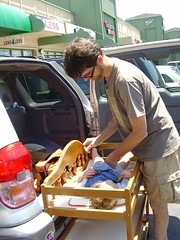*bolds added by me*Study Urges Halt To Episiotomies
By Rob Stein
Washington Post Staff Writer
Wednesday, May 4, 2005; Page A01
One of the most common surgical procedures performed in the United States -- an incision many pregnant women receive to reduce the risk of tissue tears during delivery -- has no benefits and actually causes more complications, according to the most comprehensive analysis to evaluate the practice.
Contradicting the long-accepted rationale for the procedure, called an episiotomy, the analysis found that it increases the risk of tissue tears, leading to more pain, more stitches and a longer recovery after childbirth. In addition, an episiotomy increases the risk of sexual difficulties later and does not reduce the risk of incontinence, the federally sponsored study found.
As a result, the researchers concluded, routine use of the procedure undergone by more than 1 million U.S. women each year should be discontinued, and the incision should be considered only to speed delivery when the health of the baby is at risk.
"The evidence is clear: Routine use of episiotomy is not supported by research and should stop," said Katherine E. Hartmann, director of the Center for Women's Health Research at the University of North Carolina at Chapel Hill, who led the analysis published in today's issue of the Journal of the American Medical Association. "Women need to know this information so they can talk with their care providers before they are in labor."
Other experts agreed, saying
the procedure is an example of a broader problem in medicine: Many practices that became common before their effectiveness was tested have become ingrained by tradition and continue to be practiced well after their usefulness has been questioned by research."Routine episiotomy clearly is not necessary," said Laura Riley, director of labor and delivery at Massachusetts General Hospital in Boston who chairs the obstetrics practice committee for the American College of Obstetricians and Gynecologists. "This is a message that's been out there that's clearly taken a long time to get universally accepted and universally implemented."
The new analysis was conducted for the Agency for Healthcare Research and Quality, a federal agency that conducts influential evaluations of medical procedures, at the request of the college amid growing frustration that the procedure was still being done routinely despite strong evidence questioning its usefulness, Hartmann said.
"There was a sense that without attention being focused on this, we might be stuck with these very high rates for a very long time," she said.
An episiotomy is an incision that doctors make in the perineum -- the skin between the opening of the vagina and anus. The idea is that the incision will make delivery of a child easier and that a deliberate surgical incision will heal more quickly and with fewer complications than tears that occur spontaneously, minimizing the risk of sexual problems and other complications, such as incontinence. Because the procedure has been in widespread use since the 1930s, it has been subject to careful evaluation only fairly recently.
The number of episiotomies began to decrease in the United States in the 1980s when studies started raising questions about their value. But
the procedure is still estimated to be performed in about one-third of all vaginal births -- more than 1 million of the estimated 4.2 million vaginal births that occur each year, making it more common than hysterectomies and Caesarean section deliveries. The rate varies widely around the country, but overall about 70 to 80 percent of first-time mothers undergo episiotomies.
For the study, Hartmann and colleagues scoured the medical literature for all studies on the subject between 1950 and 2004, finding 986. The researchers then identified 45 studies that provided the best data, including 26 that provided the most useful information on benefits and risks, and pooled that information for the new analysis.
Based on that data, the researchers found that women who had not undergone the procedure were no more likely to experience spontaneous tears during childbirth than those who had. In fact, those who underwent the procedure appeared somewhat more prone to tears, the researchers found.
"If you have a piece of fabric, it doesn't tear well until you get it started. The episiotomy can have that effect of actually being the starting place for a tear," Hartmann said.
As a result, women who have had episiotomies tend to need more stitches and experience more pain after childbirth, the researchers found. Women who underwent episiotomies had a 26 percent higher risk of requiring sutures.
Moreover, women who had episiotomies were no less likely to experience urinary or fecal incontinence in the three months to five years after delivery, the study found. Rather, women with episiotomies were twice as likely to suffer fecal incontinence in the first three months.
Those with episiotomies were also 53 percent more likely to suffer pain during intercourse three months after delivery.
"There's a lot of unnecessary suffering occurring to women because of the use of episiotomies," said Carol Sakala of the Maternity Center Association, a private, nonprofit group based in New York. "It's really tragic."
Sakala noted that the rate of Caesarean section deliveries has been increasing in the United States, in part because of women's fears of complications from vaginal deliveries. Unnecessary episiotomies may be a key contributing factor to those complications, she said.
"We need to send a very clear message to women and their providers," Sakala said. "The evidence clearly says that performing routine episiotomies offers none of the benefits that have been presumed in the past and in many cases offer severe harm."

















